Bathroom tiling: features and design options

It's time to renovate the apartment. You already know what to do with living quarters, since it is quite easy to find acceptable options for them. But what kind of finish to use in the bathroom - this question is not easy to answer for various reasons. For some, it is too small, and for others, it is too large. In any case, first you need to choose the material with which you will decorate the walls and floor. It must be moisture and wear resistant. Of course, the choice must fall on ceramic tiles.
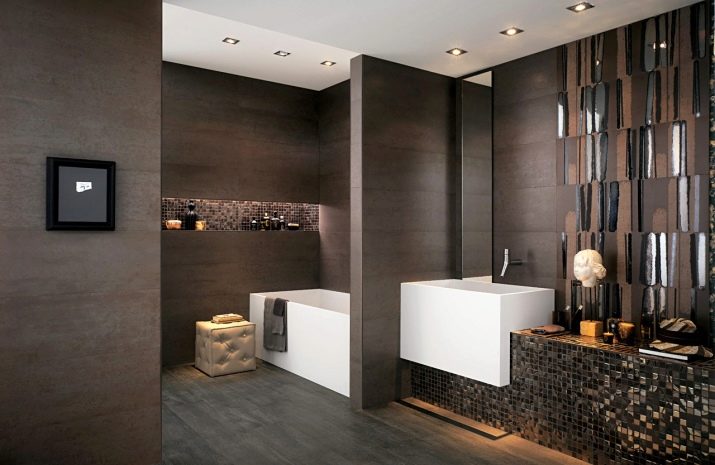

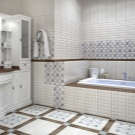
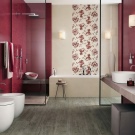
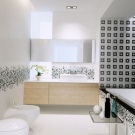
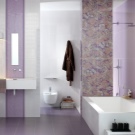
Basic rules for choosing tiles
First you need to consider that ceramic tiles are a very suitable option for decorating a bathroom. Its installation will not cause much trouble, and such work can be done by a person who has no experience in this matter.
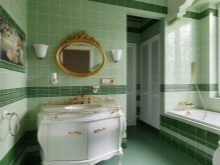
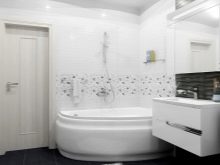
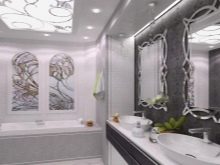
Today, a large number of products are produced that differ in the quality of performance. Someone chooses samples from well-known manufacturers, someone prefers to choose simpler products. That's why bathroom finishes vary. It all depends on the completeness of the wallet, preferences and taste.
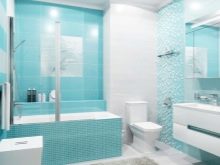

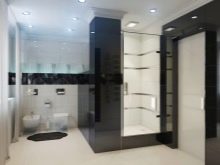
Bathrooms are also of various sizes. The area of the room and its color scheme should be in harmony. In "Khrushchev" all rooms are very small, which means that you need to choose light colors that visually increase the space.
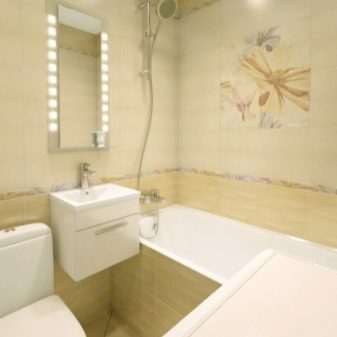

There is plenty of room to roam in a large room. Therefore, everything here will depend on the wishes of the owners. Someone wants to have a bathroom, which is lined with black tiles with light splashes, while someone prefers only snow-white shades. They emphasize the purity of thoughts and the world around them.
In addition, whitish stains from powder and water are not visible on the white tile.
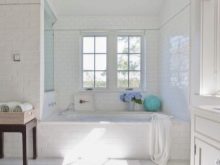
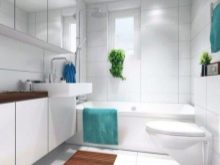

Don't use red colors in a small room. If you still want super-flashy shades, then choose a white tile with a red pattern, for example, with large flowers. Will look good on a white background and red borders.
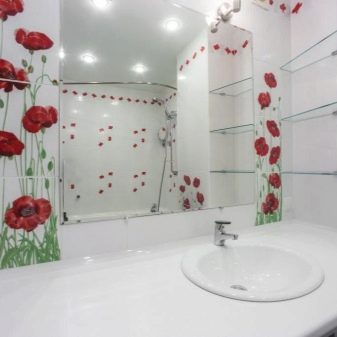
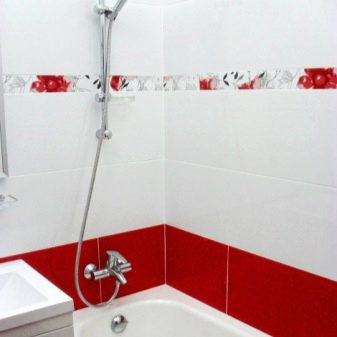
When you walk into a store, your inexperienced eye cannot immediately identify the best samples. All collections seem to be equally beautiful and of high quality. This is especially true when products have glossy surfaces. They all shimmer and shine, and your attention becomes scattered. Therefore, doubts begin. And this leads to the wrong choice. In order not to be mistaken, adhere to the following rules.
- You cannot finish the walls of the bathroom with tiles that are intended for the floor. Conversely, you cannot lay fragile wall tiles on the floor. On the floor, thin wall tiles will simply crack from stress, and heavy flooring will not adhere well to the walls.
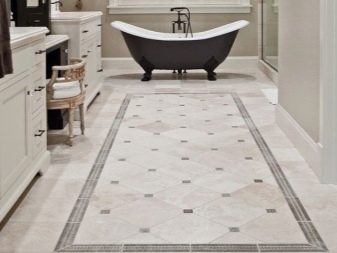
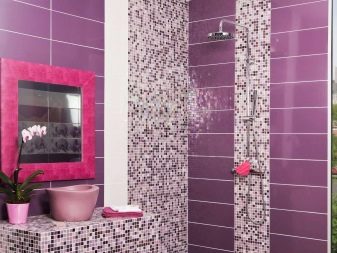
- It is not necessary to choose too thick, high-strength tile in a very small toilet space. There are not so many people living in a scanty apartment that your expensive tiles will quickly crack and wear out. Why pay extra money for excessive wear resistance when you can choose thinner samples and, therefore, cheaper.
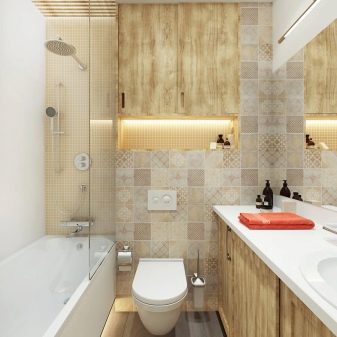
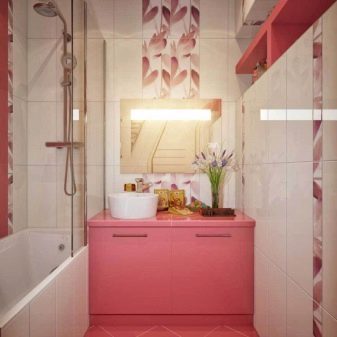
- You should not save money when it comes to purchasing tiles. It is better to buy two or three more samples than you calculated in advance. Anything can happen during installation. The piece product may crack or break. Here the fallback will come in handy.
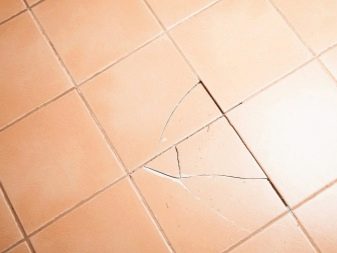
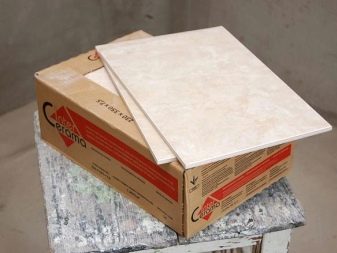
Of course, the high-quality workmanship of the products should also be at their best. That's why do not skimp on trifles and at the same time consider the following.
All piece products must match diagonally and in size. To check the coincidence of the parameters, you need to selectively take a couple of tiles from the batch, and then fold them together with the front side. If you see discrepancies, then it is better to refuse the purchase. By the way, when smooth, glossy surfaces are superimposed on each other, there should also be no free space between them (both high-quality samples seem to "stick" to each other). If you notice flaws, then the surface is not of the best quality.
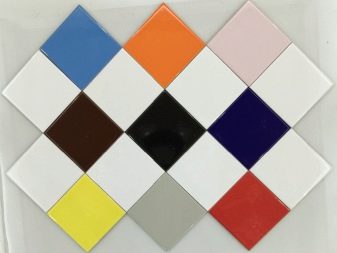
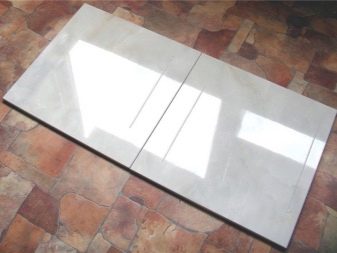
Do not forget to check the items for cracks. To do this, you need to turn the face of the specimen into the light. The presence of "cobwebs" is a marriage. The tiles are usually installed in damp rooms.
Water will definitely penetrate the small cracks that are present on the surface of the glaze, and over time, it will destroy the tiles.
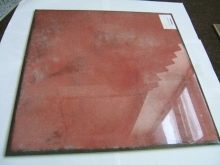
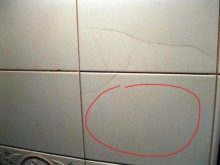
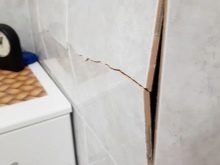
Try to get the right amount of tiles right away. Do not do it in parts, because products from the same collection may differ slightly from each other in shades and even in dimensions. And that's why. When one batch of goods ends, they bring in another. In industries, changes in the quality of goods often occur due to raw materials or a change in manufacturing technology. There is no guarantee that another batch will not be executed with some changes.
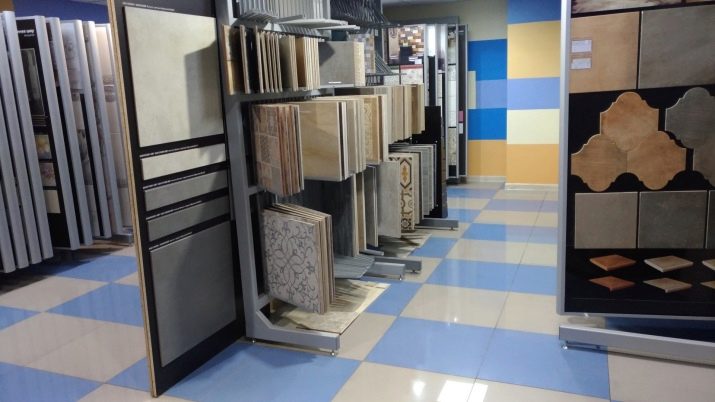
For complete confidence in your choice, you also need to rely on the advice of specialists with many years of experience. So, the general rules will be as follows.
- To visually "stretch" the space, the curbs should be stacked vertically, not horizontally. This means that the owners of small rooms should choose rectangular products.
- To get a "high ceiling", lay vertically, and arrange decorative elements at eye level. Therefore, it is also worth purchasing decorative items.
- It is better to use neutral or cold shades in the toilet. Therefore, it is necessary to buy products that will have a white or light blue color scheme.
- When you start installing tiles on the wall, it is better to use horizontal laying.The walls finished in this way will significantly increase the visual height of the ceiling. Therefore, purchase rectangular tiles.
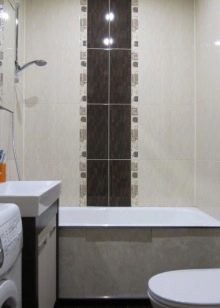
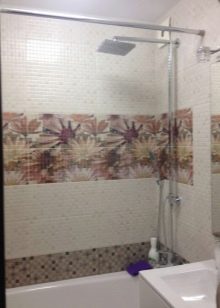
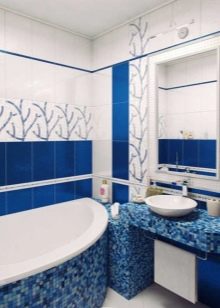
Combination options
Tiling gives unlimited possibilities for using your imagination. The main thing is that some general rules are observed here.... For example, if you decide to use several colors at once, then for decoration you need to choose only one color, from which you need to "build on". Each new shade should differ from the previous one by about 30-40%. But what tones you choose, darker or lighter, everything will depend on your desire.

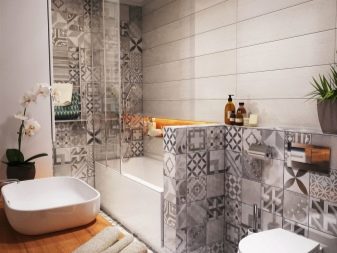
Please note before combining colors, you need to decide on the texture of your chosen products (it can vary greatly both in quality, performance, and in shape)... And if you decide to combine different textures and colors, then try not to overdo it in this matter.
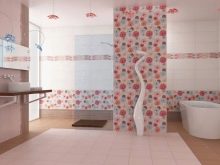
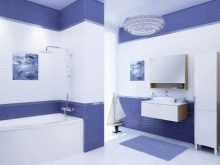

So, in order not to get confused, you need to consider all the details in order.
Colour
His choice is one of the main questions. Perhaps the options offered to you below will help you decide on it.
- Black and white contrast looks very good. Always elegant and beautiful. Just consider the area of space. The larger it is, the more formatted the drawing should be.
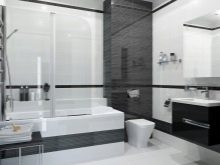
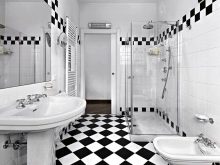
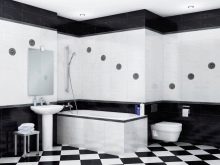
- Design performance is a combination of plain tiles (neutral) and a photopanel... The drawing can be different. It can be ordered individually. And what it will be - you choose. For example, you can even decorate the wall with tiles that will have your image on it.

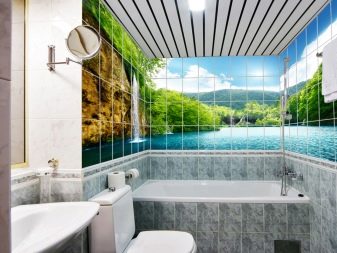
- Combinations of shades of the same color direction look good in a large toilet... This design will add volume to the room.


- Those who are used to fun and joy can use a bold combination of bright colors. In this case, the accompanying furniture and plumbing fixtures should be white.
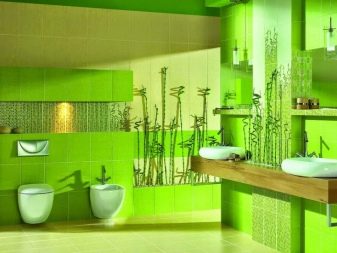
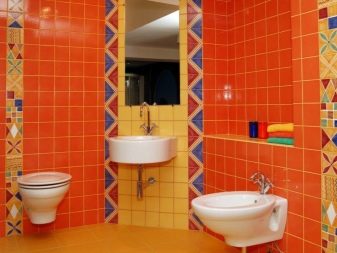
- Try to decorate the walls with ceramics of a monotone color and only slightly add bright elements (inserts can be arranged in small groups). This will give you a chaotic pattern.
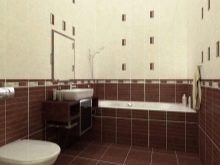

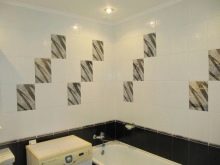
- An option that suits creative people, - this is a patchwork (connection in the order of the geometry of patterns, lines and colors).
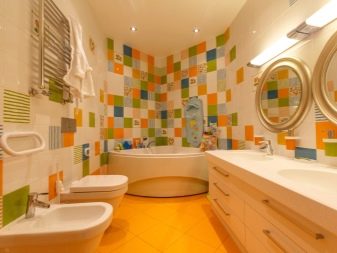

Now we will consider separately the combinations that are suitable for rooms of different sizes.
- For small spaces. A rational approach is needed here, so we choose only light shades. The tile must have a glossy surface. We cover the floor with tiles with a matte effect; in color, it should be in harmony with the walls and ceiling. It is best to make a smooth transition from the dark bottom to the light top.
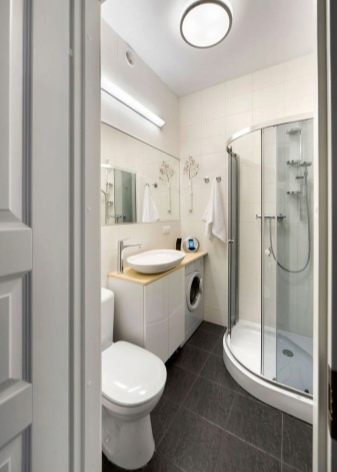

- For a toilet that is combined with a bath. Three colors can be used here. It is also possible to visually separate the zones in which the bathroom and toilet are located - with the help of color, this maneuver is quite feasible. For example, we separate the toilet area with light tiles, and decorate the space where the bathroom is located with tiles of darker shades. In the same design, we make out the floor, where we arrange the transition to the wall by about 1-3 tiles.
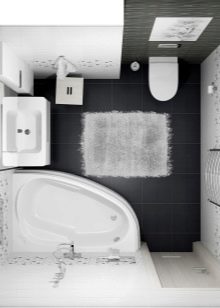


- For spacious bathrooms. Here you can apply your wildest ideas. Color options range from light shades to very dark and even black.
Contrasts look good in a huge room.
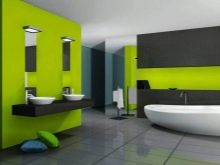
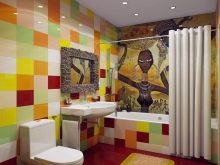

Texture
A very important point that must be taken into account when designing. People almost always choose tiles that are produced in the same factory. And this is logical. Each factory uses certain technologies and raw materials. It is because of this that the texture of different samples of ceramics differs significantly in composition and performance.
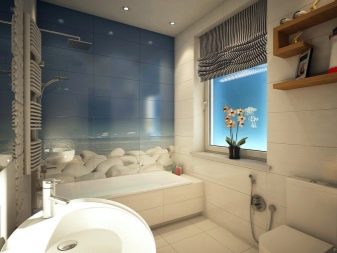

As a result, if you use different textures, the wall cladding will turn out to be not entirely harmonious. However, here, too, there are some tricks that will help make this combination quite acceptable.If the products have a certain similarity and pass from one type to another, then this "union" will be very successful.
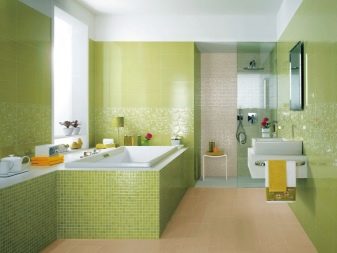
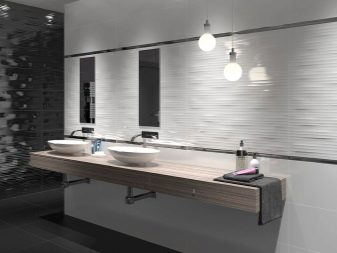
To do this, apply a finish that consists of of three types of tiles. You can also combine matte and glossy surfaces, but consider each option separately. For example, make the floor matte and the walls glossy. Also, using a matte layer, make a separate figured selection on the wall or on the floor. If you decide to apply this solution, then use different shades of tiles.

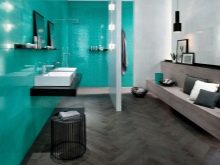
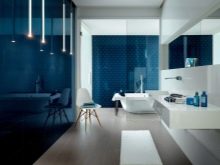
And some more details about a combination of embossed and smooth tiles. The 3D effect in the tile pattern is very modern. Light and shadows do their job and give the picture dynamism and volume. With such an unusual combination, you will definitely not overload the space with volume.


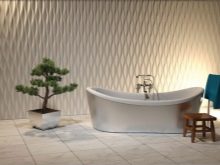
Perfect combination gives tiles of different shapes... These types are stacked either chaotically or in a certain order. It should be noted here that the implementation of such an ornament requires some preparation. As a result of the effort, your space will take on an elegant look.
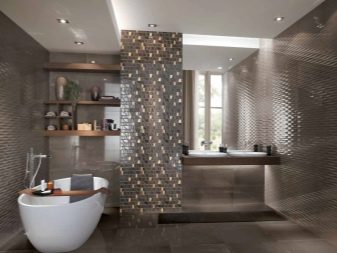
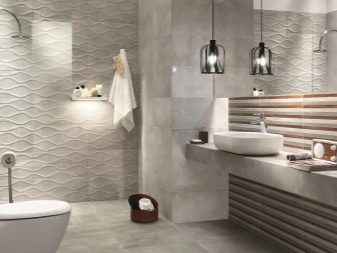
Tiles of different sizes, laid out in a specific order, always stand out from other examples. This layout will look perfect if the products do not differ significantly from each other. For more effect, play with the color scheme as well.
For example, make a certain pattern in this way.
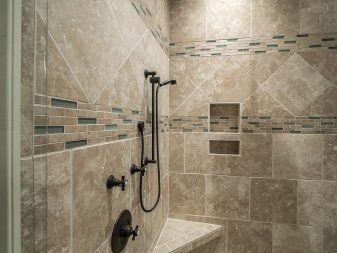

Combination with other materials
People love to experiment. The various combinations result in highly attractive interiors. Ceramic tiles are no exception. Consider the variations in the performance of different combinations.
- Wood gives comfort and warmth to the room, and the tile, on the contrary, is cold. When these elements are combined, we get cleanliness, order and rustic comfort. With the right choice of color, it will come out quite organically.
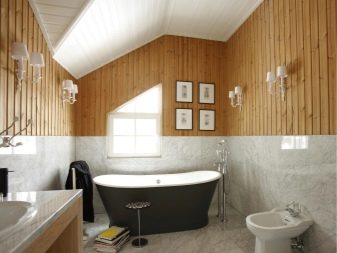

- Waterproof wallpapers always look great. When tiles and wallpaper are combined, it gets pretty cozy. The only caveat: the wallpaper should be glued to the walls in a place where there will be no excessive moisture. To make the combination most acceptable, combine the wallpaper and tiles in this way: a tile of a simple shape without a pattern will look good against the background of bright floral patterns that adorn the wallpaper.
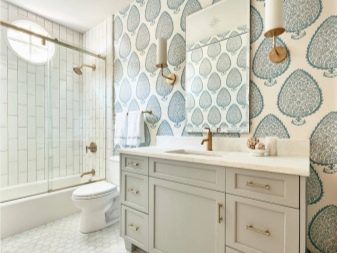
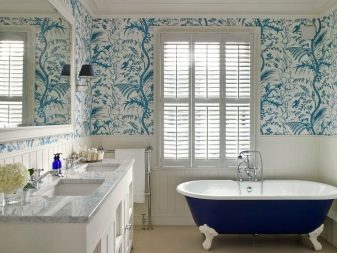
- If the tile, on the contrary, has very bright shades and patterns, then wallpaper should be plain and light.
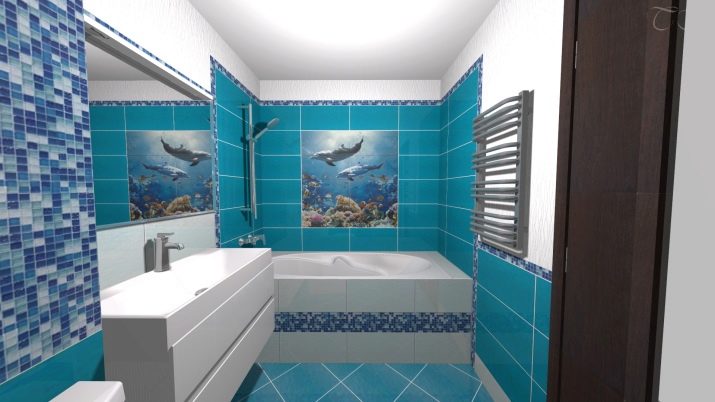
- Combination of painted walls and walls, decorated with ceramics, will save you a little. Tiles of all shapes and sizes are suitable here. Only use high quality waterproof paint.
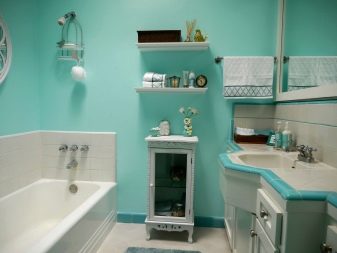
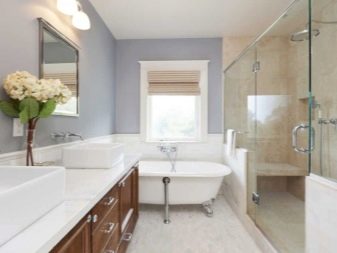
- Porcelain stoneware is durable and durable. This is how it differs from ordinary tiles. In addition, this material stands out for its very impressive dimensions and quality factor in comparison with tiles. If you combine tiles and porcelain stoneware, you can create a certain mood and highlight separately each zone in the room.


- The space can be supplemented with decorative panels. Combining them with ceramic tiles will look pretty good. Mirrored tabs are a great addition. Natural marble is also well suited for these purposes (it can be replaced with artificial one).
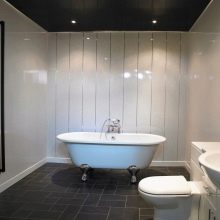

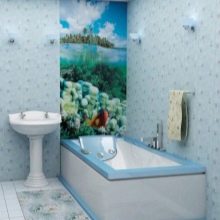
- And finally, the mosaic. The most efficient and expensive combination. You can have any layout. From panels to plain colors. The mosaic is also decorated with a frame made of additional tiles. In a small room, this combination will look better if it is done in the same color style.

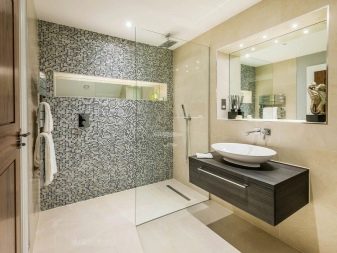
Laying methods
Tiled decoration of any room is present in almost every home. Fortunately, there are many different products on the market that give free rein to the imagination of designers and ordinary people. Modern ceramics are more and more like art, and the use of different colors and textures makes the process exciting.
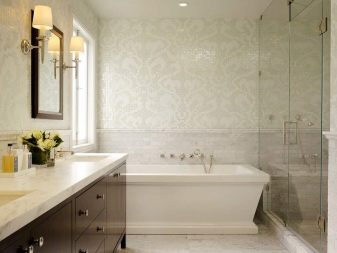
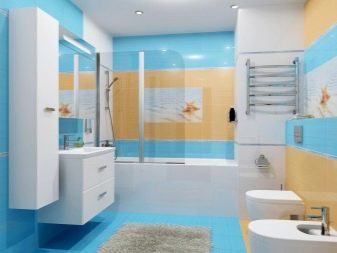
Tiles are laid as follows.
First you need to spend high-quality floor screed. For this, beacons are used that allow you to determine the correct horizontality. After pouring the solution, at least 4 weeks should pass, and only after that you can proceed to the next stage.
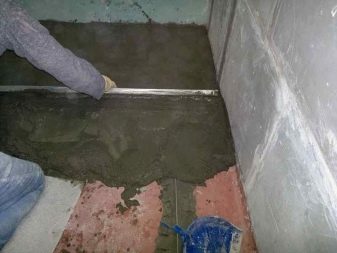
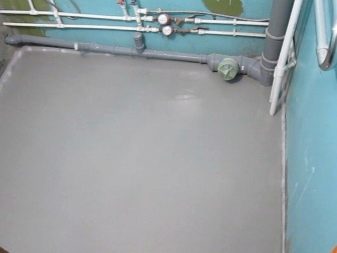
On the finished surface it is necessary make markings and choose a styling method. We mark out using a cord, a level and a tape measure.
Then we get down to more serious work. To do this, we dilute the glue and "beat" it with a special attachment, which is attached to a drill (you can take a construction mixer). In order not to be mistaken in the dosage, we dilute a small amount. After mixing the glue, wait about 10 minutes. During this time, all additives will dissolve properly.
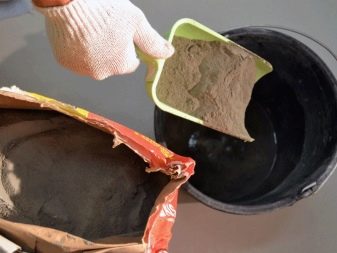

Apply the finished mixture to the surface. Its perimeter should not exceed 1 sq. m. Using a larger surface will mean that you will not have time to lay the tiles, as the mixture will quickly harden.
We put a tile on the applied base, press it in, check it with a level. The surface must be free from deviations.... In order for each sample to lay correctly and evenly, the distance between them must be fixed using plastic crosses (usually they are sold together with the tile). If you need to cut a piece from a tile, then this can be done using a grinder or tile cutter.
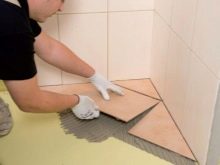
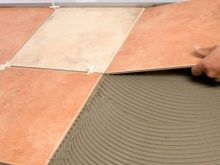

Leave the surface to dry completely for 2-3 days. It is not recommended to walk on it at this time.
We clean the finished plane from excess of the hardened mixture and rub the seams with grout. What color the grout will be is up to you. When it hardens, remove its excess with a damp cloth.

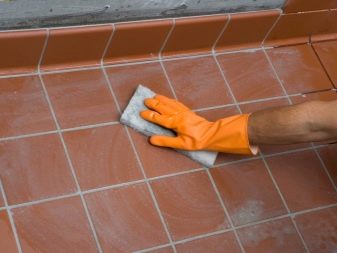
Some subtleties: if you decide to lay tiles not only on the floor, but also on the walls, then start all work from the walls.
Now let's look at the styling methods.
- There is a traditional method... It does not require any special training. Still, this type of styling visually increases the space well. Here you can apply a combination of different shades and get such patterns: in the form of straight lines, a checkerboard, as an ornament, in the form of cross lines or a kaleidoscope.
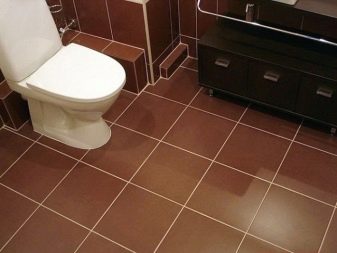

- Diagonal installation of products helps to hide subtle irregularities. If you choose a drawing in the form of a checkerboard, then such flaws become completely invisible. However, in this case, be prepared to waste material.
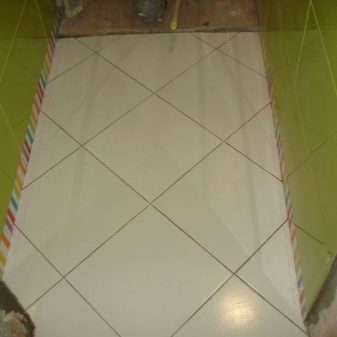

- Where a high surface load is foreseen, apply stacking with an offset. It provides for the absence of clear corners.
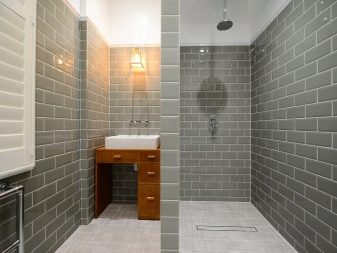
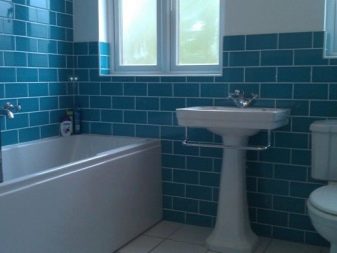
- The herringbone method is good for rectangular ceramics. If you have a room with the wrong layout, then it will look perfect. For walls, you can apply a variety of formats.
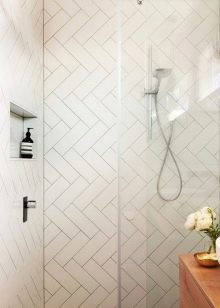
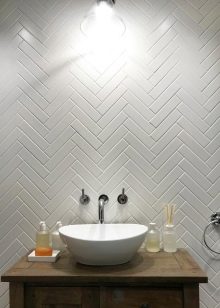
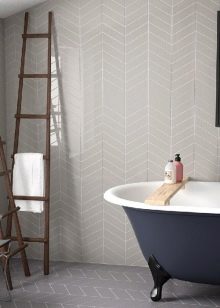
- Irregular pattern or modular grid method provides for the laying of products that have different sizes and colors. This method is inconvenient in that it requires a careful approach, fitting individual samples and preliminary calculation.
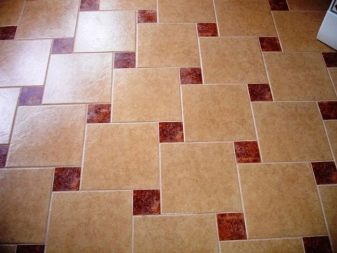
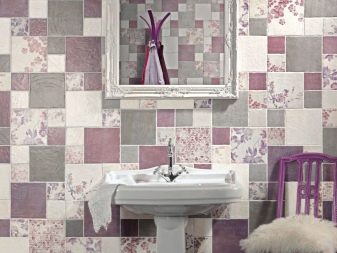
- And there is also a "non-standard" type of tile installation... It is often used by designers. It provides for the use of several methods of laying tiles at once in one room.
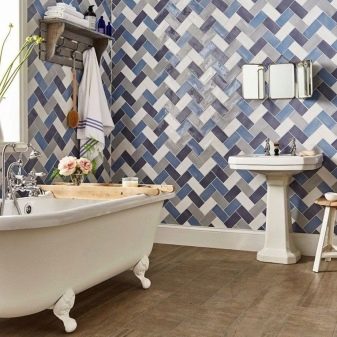

Beautiful examples
Of course, it is better to see once than hear a hundred times. Therefore, it would be nice to look at ready-made examples, and only then apply them at home during the renovation.
- Many people often mount rectangular tiles on the walls. Horizontal masonry visually makes the room wider, vertical layout significantly narrows the room and makes it higher.
If the color and grout are correct, then these examples will only emphasize your taste.
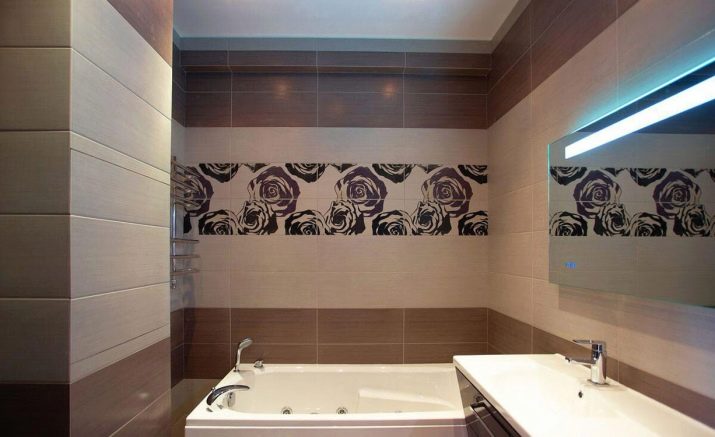
- An excellent solution is laying the tiles in the form of guide strips. Tiles of a different color, laid in the form of stripes, help the eye "slide" along the walls, and this effect emphasizes the individual approach to the decoration of the room.
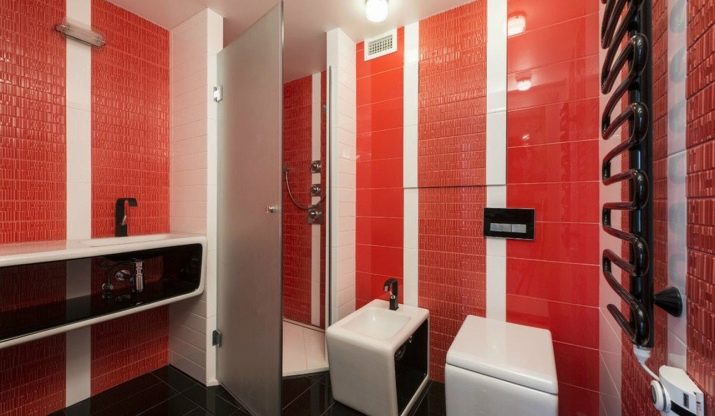
- The classics of performance are white tones. This direction is chosen by successful and confident people.
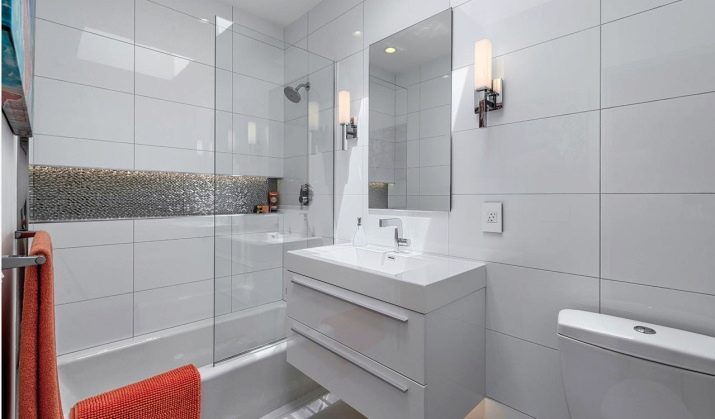
- Dark shades they are used a little less often, but this makes them most attractive to those who love personality. Typically, these options are used in large rooms. Only wealthy people can afford to arrange a strict and solemn atmosphere in all corners of their home.
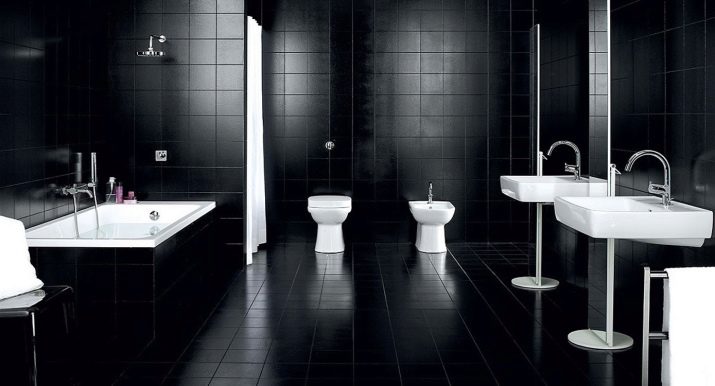
- Diagonal tile laying - this is a rarity, and all because this process is very difficult and time consuming. However, this type of decoration of the toilet space is amazing.

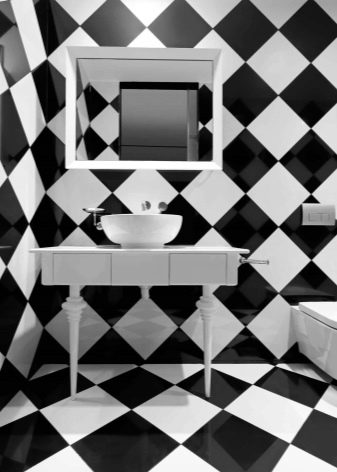
- The marine theme looks pretty good... Sandy and varied shades of blue give the impression of the general mood that is present in the nautical direction. Usually, this is the way to decorate rooms that combine the toilet area and the bathroom area.
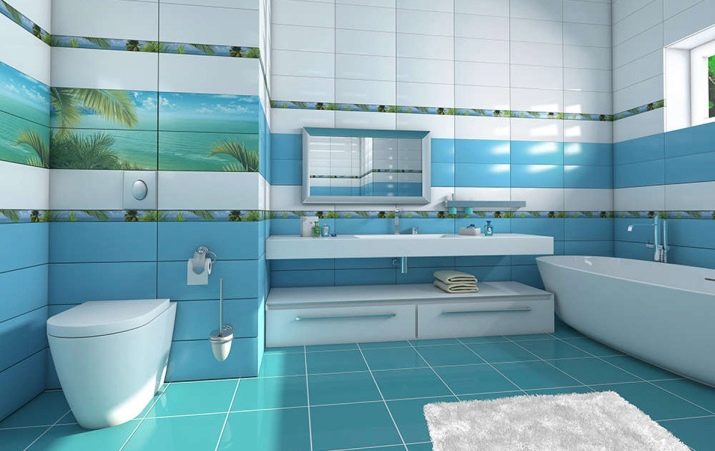
- Anyone who strives for excellence in everything can apply for decoration brown shades... If you dilute them with white, you get quite stylish and presentable.









